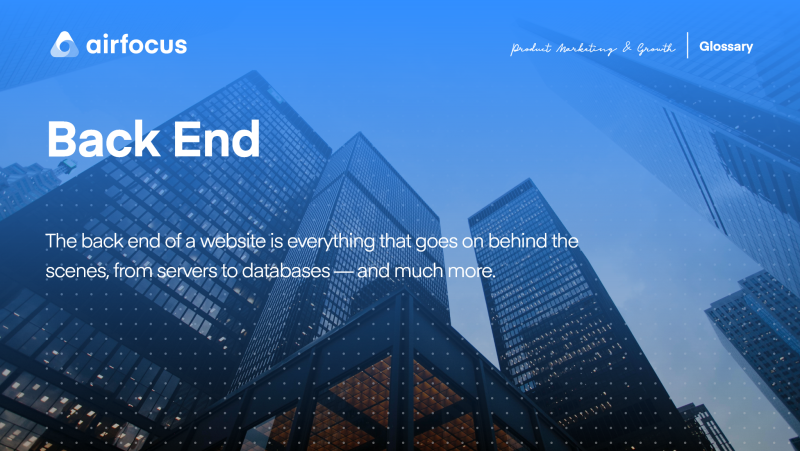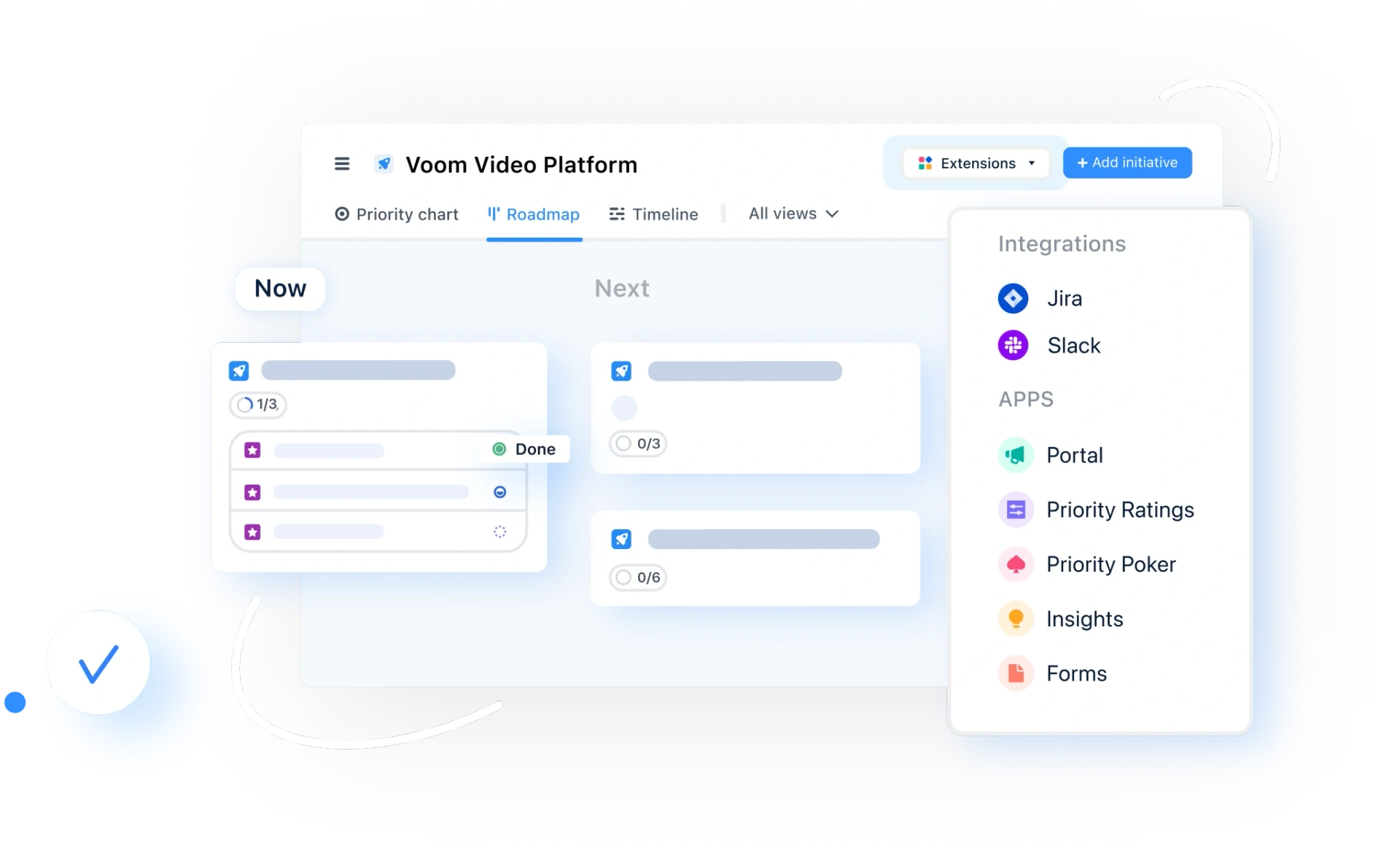Back End (In a Website)
Discover how understanding the back end helps product leaders drive smarter trade-offs, roadmap decisions, and cross-functional alignment, with help from airfocus.
What is a back end (the short, useful answer)
Definition of back end (in websites)
The back end of a website is everything that goes on behind the scenes, from servers to databases, and much more.
What is a back end in product management? “Back end” describes the parts of an application or program’s code that enable it to operate.
These include:
Server
Database
API logic
Infrastructure
In a nutshell, a website’s back end is everything the user doesn’t see. It is the beating heart, or the churning engine of a website — responding to requests made by the user by sending information from the back end to the front end to be displayed.
Users cannot access the back end, but it’s essential to a product’s overall functionality and performance. This is in sharp contrast to the front end: the presentation layer that users interact with, ideally delivering a strong user experience (UX).
Users may not understand what a back end does, but they’ll appreciate one that’s well designed, even if they’re unaware of it.
And it’s not a case of front end vs. back end: one isn’t more important than the other. The back end and front end must work harmoniously to deliver a great product.
Why product leaders should care about the back end
Let’s look at three key areas to understand why a product’s back end matters:
Back-end complexity affects key product decisions
Strong back-end product management helps ensure your application can handle growth, support user needs, and evolve. But a poorly designed or overly complex back end can hold your team back, slowing delivery, limiting feasibility, and complicating prioritization.
Here’s how back-end architecture influences key areas of product management:
Velocity and feasibility: A streamlined back end enables faster development. If the architecture is too complex, even minor feature updates may require significant engineering effort, slowing teams down.
Prioritization and trade-offs: Product leaders who understand the back end can better judge which features are worth the effort and which ones might introduce unnecessary complexity or risk.
Scalability and performance: Knowing how well your back end handles user load and simultaneous actions helps you plan for scale. A solid architecture means fewer performance issues as your user base grows.
User experience (UX) impact: Users may not see the back end, but they feel its effects through page speed, reliability, and performance. This is where understanding front-end vs. back-end dynamics becomes especially useful. The back end quietly powers the experience users engage with up front.
Roadmap alignment: Back-end limitations can affect what gets built and when. A realistic roadmap needs to account for architectural constraints, refactors, and infrastructure upgrades, not just front-end changes.
By understanding how the back end affects feature feasibility, scalability, and UX, product leaders can collaborate more effectively with engineering, set achievable goals, and build roadmaps grounded in technical reality.
Make smarter roadmap trade-offs
Understanding the back end helps product leaders speak the same language as engineering, which is essential when weighing trade-offs during roadmap planning.
When you understand how a proposed feature might strain the back end or conflict with existing limitations, you can have more strategic conversations with engineering leads. Instead of relying entirely on technical explanations, you can actively engage in the decision-making process.
This shared understanding means better alignment and trust across teams. Everyone stays on the same page, and you can discuss trade-offs (like performance vs. time to market, or ease of build vs. long-term value) transparently.
Navigate tech debt and system limitations
Back-end architecture plays a major role in shaping long-term product health, and product leaders need to understand the risks that come with shortcuts or aging systems.
When you know how back-end decisions contribute to tech debt, you can better evaluate the trade-offs between fast fixes and long-term value. This helps you guide strategic conversations: Is that quick win worth the complexity it might add later?
The same applies to legacy systems and performance bottlenecks. If the back end is outdated or underperforming, it can limit your ability to ship new features, scale effectively, or deliver the kind of UX users expect.
When should back-end factors influence your product decisions?
Let’s look at a few examples of situations where back-end changes drive a product’s direction.
Infrastructure changes tied to roadmap initiatives
When teams adjust a product’s back-end infrastructure, this can cause front-end changes that impact the user experience. With this in mind, product leaders should always ask how infrastructure changes will affect their roadmap initiatives.
Try to pinpoint any implementations that you can’t make now, along with any that are achievable yet difficult.
Prioritizing back-end refactors
Code refactoring is a restructuring process performed to improve a platform’s internal structure and server-side code, all without affecting its functionality. Essentially, this is a deep clean for software, and can enhance its performance overall. By making the code less complex, you can reduce the number of unnecessary dependencies and the code's running time.
Refactoring makes maintaining code easier, ensures that a platform continues to match changing standards, and keeps its performance consistent.
Because refactoring can be so beneficial, aim to include it in roadmap planning as part of your back-end product management process. Consider technical dependencies carefully, and compare the pros and cons of new features against the value they’ll add to a product.
Scaling systems and preparing features
How scalable is your product’s back end? Scaling can be a problem in legacy systems, along with user expectations for functionality and UX. Product teams should have the flexibility to scale their back-end infrastructure in response to evolving needs and new features. But overly complex back-end code hinders scalability.
However, back-end updating and refactoring can help a product align with user needs while boosting its future-readiness overall.
Planning and roadmap alignment
When planning roadmaps, leaders should make sure that the product team’s initiatives align with technical constraints or back-end rebuild/refactoring timelines.
Using product roadmap software streamlines the planning process, providing product leaders with the tools and templates to create a comprehensive visual strategy.
Prioritization conversations
Back-end complexity directly affects how much effort a feature takes and needs to be part of your product prioritization process.
Even simple changes can involve significant back-end work. When product leaders understand these technical constraints, they can score features more accurately and set clearer expectations.
This leads to more grounded, transparent conversations and better decisions about what to build next.
Capacity planning
Effective capacity planning requires understanding how work is distributed across teams, especially when front-end vs. back-end responsibilities come into play.
When product leaders understand the back end, they can better anticipate where engineering time will be needed and allocate resources accordingly. This helps avoid bottlenecks, align team efforts, and ensure no area (front end or back end) is stretched too thin.
How product leaders can talk about the back end (without hand-waving)
Product leaders can frame back-end discussions within the user experience and needs. When discussing back-end structure and changes, focus on their impact on the product’s ability to meet user requirements.
By focusing more on the strategic aspects rather than the technical, product leaders can effectively emphasize why the product needs to fit the target user. This can help translate technical concepts into strategic initiatives through streamlined roadmaps and in OKRs meetings.
It’s also important to encourage partnering with product engineers instead of competing for ownership. The goal isn’t to take charge of the engineering team or go head-to-head with their leaders. Instead, it’s about recognizing that you’re all working together to achieve the same goals.
Clarify to other stakeholders that you’re here to:
Collaborate
Prioritize the user
Connect business goals to back-end and technical requirements
Put a comprehensive plan into action
How airfocus helps product leaders make better back-end decisions
airfocus is the trusted AI-powered product management platform that enables product leaders to align teams and keep everyone on track. airfocus includes a wide range of essential tools to help align cross-functional work throughout a product’s lifecycle, including:
Prioritization scoring models with custom frameworks
Integrations with popular dev tools (e.g., Jira, Azure DevOps)
Multiple roadmap views (e.g., release, timeline)
AI tools for product managers to maximize efficiency
Objectives and key results software for setting measurable goals
Using airfocus, you can build the right plan for your product and features, bringing teams together with improved visibility and transparency.
Product alignment starts behind the scenes
Strategic roadmap planning and prioritization are a must for any successful release, but effective back-end product management plays a critical role from the start. To bring all the components together, you need a comprehensive product management platform. That’s where airfocus comes in.
To discover how airfocus can help with your roadmap planning, prioritization, and cross-functional team alignment, book your tailored demo today.

General FAQ

Glossary categories
Experience the new way of doing product management

Experience the new way of doing product management








